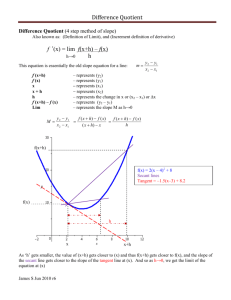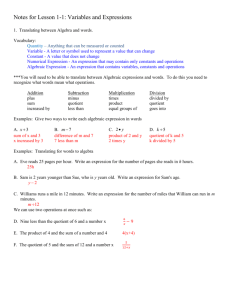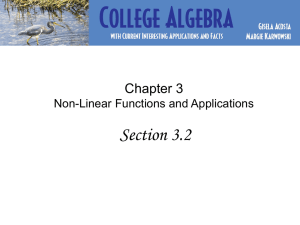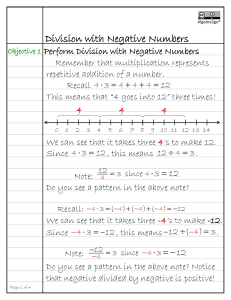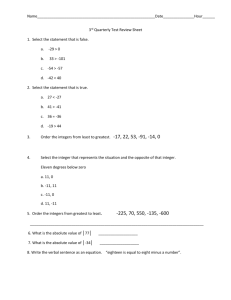THE DIFFERENCE QUOTIENT
advertisement
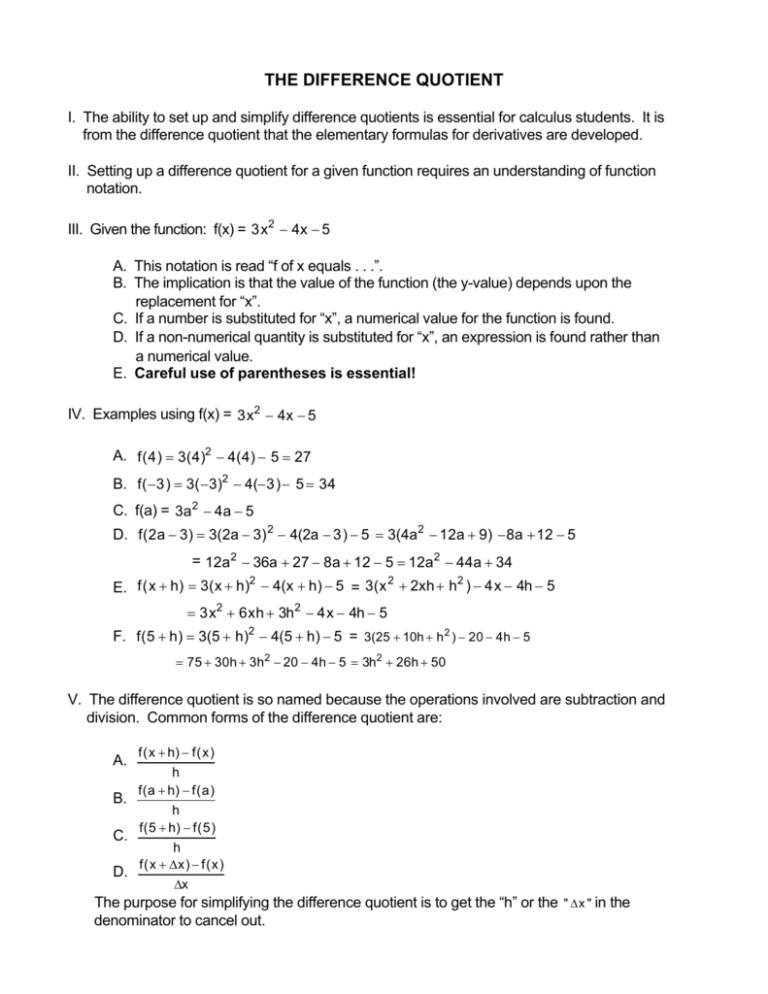
THE DIFFERENCE QUOTIENT I. The ability to set up and simplify difference quotients is essential for calculus students. It is from the difference quotient that the elementary formulas for derivatives are developed. II. Setting up a difference quotient for a given function requires an understanding of function notation. III. Given the function: f(x) = 3x2 − 4x − 5 A. This notation is read “f of x equals . . .”. B. The implication is that the value of the function (the y-value) depends upon the replacement for “x”. C. If a number is substituted for “x”, a numerical value for the function is found. D. If a non-numerical quantity is substituted for “x”, an expression is found rather than a numerical value. E. Careful use of parentheses is essential! IV. Examples using f(x) = 3x2 − 4x − 5 A. f(4) = 3(4)2 − 4(4) − 5 = 27 B. f( −3) = 3( −3)2 − 4(− 3) − 5 = 34 C. f(a) = 3a2 − 4a − 5 D. f(2a − 3) = 3(2a − 3) 2 − 4(2a − 3) − 5 = 3(4a2 − 12a + 9) − 8a + 12 − 5 = 12a2 − 36a + 27 − 8a + 12 − 5 = 12a2 − 44a + 34 2 2 2 E. f(x + h) = 3(x + h) − 4(x + h) − 5 = 3(x + 2xh + h ) − 4x − 4h − 5 = 3x2 + 6xh + 3h2 − 4x − 4h − 5 F. f(5 + h) = 3(5 + h)2 − 4(5 + h) − 5 = 3(25 + 10h + h 2 ) − 20 − 4h − 5 = 75 + 30h + 3h2 − 20 − 4h − 5 = 3h2 + 26h + 50 V. The difference quotient is so named because the operations involved are subtraction and division. Common forms of the difference quotient are: f(x + h) − f(x) h f(a + h) − f(a) B. h f(5 + h) − f(5) C. h D. f(x + ∆x) − f(x) ∆x A. The purpose for simplifying the difference quotient is to get the “h” or the " ∆ x " in the denominator to cancel out. VI. Examples using f(x) = 3x2 − 4x − 5 [see IV for the “f(x + h)” substitution] 2 2 2 A. f(x + h) − f(x) = [3x + 6xh + 3h − 4x − 4h − 5] − (3x − 4x − 5) h h 3x 2 + 6xh + 3h2 − 4x − 4h − 5 − 3x 2 + 4x + 5 6xh + 3h2 − 4h = h h h(6x + 3h − 4) = = 6x + 3h − 4 h = B. f(a + h) − f(a) = 6a + 3h − 4 h C. f(5 + h) − f(5) [3(5 + h)2 − 4(5 + h) − 5] − (3 g 52 − 4(5) − 5) = h h [steps are identical to A, but using “a” for”x”] 2 2 = [3(25 + 10h + h ) − 20 − 4h− 5] − (75 − 20 − 5) = [3h + 26h + 50] − (50) h h 3h + 26h h(3h + 26) = = 3h + 26 h h 2 = VII. Examples using radical functions A. Given f(x) = x 1. f(x + h) − f(x) = h x+h − x . h 2. Multiply by the conjugate of the numerator to rationalize the numerator. = x + h − x x + h + x h x+ h + x 3. = (x + h) − x h( x + h + x ) = h h( x + h + x ) = 1 x+h + x B. Given f(x) = x 3+h− 3 = 3 + h − 3 3 + h + 3 h h 3 + h + 3 (3 + h) − 3 h 1 = = = h( 3 + h + 3) h( 3 + h + 3) 3 +h + 3 f(3 + h) − f(3) = h C. Given f(x) = 3x + 2 3(x + h) + 2 − 3x + 2 h f(x + h) − f(x) = h 3(x + h)+ 2 − 3x + 2 3(x + h)+ 2 + 3x + 2 h 3(x + h)+ 2 + 3x + 2 = = [3(x + h) + 2] − (3x + 2) 3x + 3h + 2 − 3x − 2 = h( 3(x + h)+ 2 + 3x + 2 ) h( 3(x + h)+ 2 + 3x + 2 ) = 3h = h( 3(x + h)+ 2 + 3x + 2 ) 3 3(x + h)+ 2 + 3x + 2 VIII. Examples using rational functions A. Given g(x) = 1 x 1 1 − g(x + h) − g(x) 1. = x+ h x h h 2. Multiply both numerator and denominator by the LCD of the “small” fractions to simplify the complex fraction. 1 1 x + h − x (x + h)(x) x − (x + h) −h −1 3. = = = h h(x + h)(x) x(x + h) (x + h)(x) h(x + h)(x) 1 B. Given g(x) = x −1 = x 1 1 − g(3 + h) − g(3) (3 + h)−1 − 3 −1 1. = = 3+h 3 h h h 1 1 3 + h − 3 [3(3 + h)] −1 2. = [see A.3 for steps] = 3(3 + h) h [3(3 + h)] C. Given f(x) = x x +1 x +h x − f(x + h) − f(x) ( x + h) +1 x +1 (x + h + 1)(x + 1) 1. = (x + h + 1)(x + 1) h h ( x + h)(x + 1) − x(x + h + 1) 2. = h(x + h + 1)(x + 1) = x 2 + x + hx + h − x 2 − xh − x h 1 = = h(x + 1)(x + h + 1) h(x + 1)(x + h + 1) ( x + 1)(x + h + 1) D. Given f(x) = 4x x −5 4(x + h) − 4x f(x + h) − f(x) 1. = x + h − h5 x − 5 h 2 2 = 4x − 20x + 4xh − 20x − 4x − 4xh − 20x 2. h(x + h − 5)(x − 5) = −20h −20 = h(x + h − 5)(x − 5) ( x + h − 5)(x − 5) IX. Practice problems: find and simplify A. B. C. D. f(x) = −5x 2 + 3x − 7 f(x) = 4x3 + 6 f(x) = 7x − 8 f(x) = 9 − 5x 3x 4 − 2x 4 − 2x F. f(x) = 3x + 1 E. f(x) = X. Answers to practice problems A. − 10x − 5h + 3 B. 12x 2 + 12xh + 4h 2 C. D. 7 7x + 7h − 8 + 7x − 8 −5 9 − 5x − 5h + 9 − 5x 3 E. ( 2 − x)(2 − x − h) F. (x + h − 5)(x − 5) 4(x + h)(x − 5) − 4x(x + h − 5) = h(x + h − 5)(x − 5) (x + h − 5)(x − 5) −14 (3x + 1)(3x + 3h + 1) f(x + h) − f(x) for each function. h
